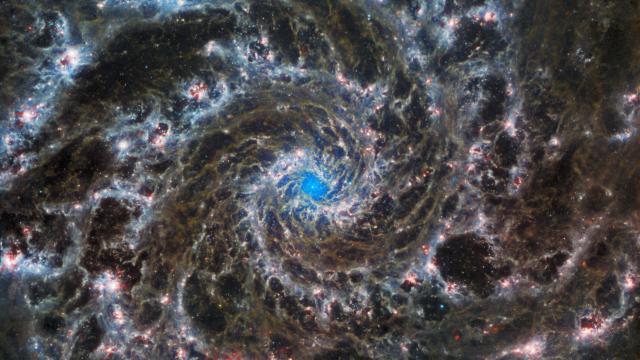On July 12, NASA released the Webb telescope’s first images. Now, the space agency has translated the data from those images into sounds, allowing us to hear the cosmic wonders the telescope saw.
Webb images in the near-infrared and mid-infrared, which encompass wavelengths human eyes are not capable of seeing. The telescope’s images are themselves translated from raw data into light we can see, a process detailed here. The sonified images go a step further, by taking those infrared wavelengths and mapping them to pitches of sound. They depict the Cosmic Cliffs of the Carina Nebula, the Southern Ring Nebula (in both near-infrared and mid-infrared), and the spectra of the exoplanet WASP-96b’s atmosphere, which indicated the presence of water.
These sonifications, as they’re called, translate the data from different sources in the image into different sounds. In the case of the Carina Nebula image, which depicts vast columns of gas and dust and young stars, brighter light was made louder than fainter sources. The lower in the image the light source was, the lower the assigned frequency of the sound was.
The Webb telescope launched in December 2021, and reached its observation point in space — about one million miles from Earth — a month later. The telescope then underwent months of commissioning its instruments and aligning its mirrors, but now it is fully operational and taking remarkably sharp images of some of the faintest and earliest light sources in the universe.
“These compositions provide a different way to experience the detailed information in Webb’s first data,” said Quyen Hart, a senior education and outreach scientist at the Space Telescope Science Institute, in a NASA release.
“Similar to how written descriptions are unique translations of visual images, sonifications also translate the visual images by encoding information, like colour, brightness, star locations, or water absorption signatures, as sounds,” Hart added.
The Southern Ring Nebula’s sound was two-fold. The nebula was imaged in both near-infrared and mid-infrared light, which highlights different features of the supernova remnant. If you listen closely, you’ll hear that the translated sound from the mid-infrared image is lower, corresponding to the fact that mid-infrared light has longer wavelengths than near-infrared light. On the whole, the Southern Ring audio is a little spookier than the Carina Nebula sound.
The exoplanet spectra — which is a graph of data points representing components of the gas giant’s atmosphere — sounds a bit like the long slides used in cartoons to indicate a falling anvil. The NASA team added ploinks to indicate points in the data that bore the signature of H20–water in the planet’s atmosphere.
The musical makeover of the Webb images comes on the heels of NASA’s sonification of the black hole at the centre of the Perseus galaxy cluster. That sound, you’ll find, is a lot more ominous than the whimsical and ethereal vibes of the Webb soundscapes.
The Perseus audio was also transposed up dozens of octaves — the actual sound of ripples in the gas surrounding the Perseus black hole is about 57 octaves below middle C, which is about 262 Hz.
As the Webb telescope observes new targets, from dazzling deep fields to specific star clusters, we should expect more of these sonified images. They’re another way to experience the cosmos, and one that’s (for the most part) easy on the ears.
